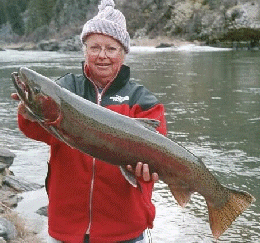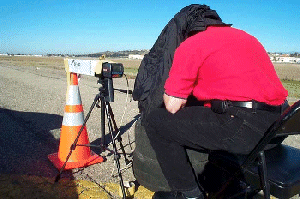10.
Some linearisation applications
Let’s
now investigate a few more regression problems. In
each case we provide:
- Data in the Scatterplot
applet – scroll down the drop-down list, select the appropriate
file, click Load Data File and then Update Display.
You can edit the data or the variables.
- An Excel file
with the data in a table and in a scatterplot. Use the Trendline
facility to determine an appropriate model for the situation.
You can use the Scatterplot
applet to help you to linearise the data and thus to decide which type
of model (linear, quadratic, exponential, …) is the most suitable
for the situation. You can then find the equation of the model either
using Excel’s Trendline, or reverse the transformations
used to linearise the data in the Scatterplot applet.

|
A stone
is dropped from a high bridge. A camera takes a photo of the
falling stone every 0,4 seconds, and the total distance the
stone has fallen is then measured and calculated from the
photograph:
|
Time
elapsed (x
seconds) |
0 |
0,4 |
0,8 |
1,2 |
1,6 |
2,0 |
|
Distance
fallen (y
metres) |
0 |
0,78 |
3,14 |
7,04 |
12,56 |
19,6 |
Find an
appropriate model describing how the distance changes as the
time changes.
Use your model to predict y(10).
To linearise
the data, load the Stone data in the Scatterplot
in the drop-down list, scroll down to Stone, load
it, and update the display. To use Excel, click on the Excel
stone button:

|
|
When
angling, it is often relatively easy to measure the
length of a fish, but not so easy to weigh it! The following
table shows known data of length (in centimetres) and
weight (in kilograms) of trout:
| Length
(x
cm) |
Weight
(y
kg) |
| 27 |
0,22 |
42 |
0,85 |
46 |
1,12 |
54,5 |
1,86 |
60 |
2,49 |
68 |
3,63 |
72,5 |
4,4 |
85 |
7,09 |
|
 |
Use the
data to find an algebraic model of the relationship between
length and weight of trout, and use the model to estimate
the weight of a 20 cm and of a 120 cm trout fish.
You can
use the Scatterplot (in the drop-down list, scroll down to
Trout, load it, and update the display). You can
also use this Excel worksheet. There is a discussion included.

|
|
|
The table
shows two sets of data for the stopping distances of a car
at various speeds: “normal brakes” and special
racing brakes.
| Normal
brakes |
| Speed
(x
km/h) |
Distance
(y
m) |
80 |
76,4 |
100 |
105,8 |
110 |
122,4 |
120 |
138,2 |
|
| Racing
brakes * |
| Speed
(x
km/h) |
Distance
(y
m) |
96 |
55,2 |
128 |
90,6 |
160 |
134 |
| |
|
|
*
This data has been converted from miles per hour to kilometres
per hour. For the original data, see:
Zeckhausen
Racing: Testing brakes |
|
Use
Excel’s Trendline to find an appropriate model
for stopping distance vs speed for normal brakes and
for racing brakes.
Use the models to predict the stopping distance for
each kind of brake at a speed of 40 km/h and at 140
km/h. You can use this Excel worksheet, which also has
a discussion.

|
 |
|
|
|
Robert Boyle (1627-1691)
investigated the relationship between the pressure and
volume of a gas. Sample data are shown.
Load
the Boyle data in the Scatterplot – linearise
the data and deduce the relationship between pressure
and volume.
Also
open the Excel Boyle tool and a try to find an appropriate
model …

|
| Pressure
(x) |
Volume
(y) |
0,5 |
21 |
0,56 |
19 |
0,63 |
17 |
0,71 |
15 |
0,83 |
13 |
0,99 |
11 |
1,09 |
10 |
1,21 |
9 |
1,37 |
8 |
1,58 |
7 |
1,83 |
6 |
2,2 |
5 |
2,72 |
4 |
|
|
|
|